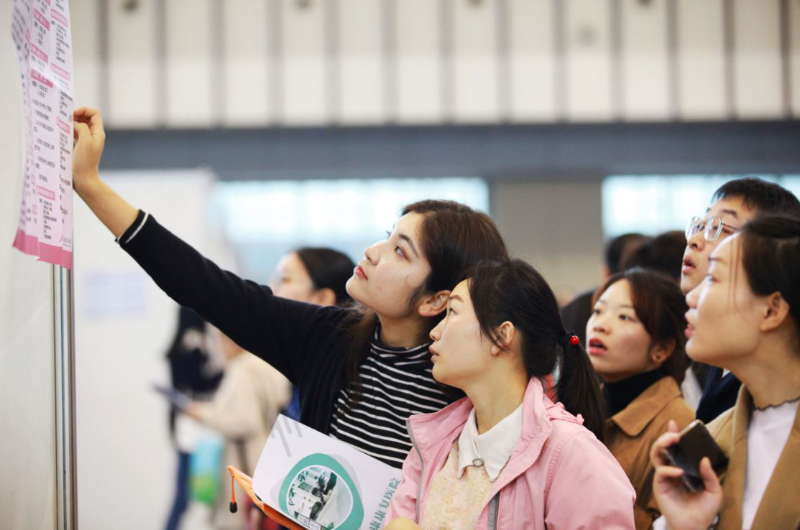Stable Job Market A Priority

Candidates look at employment opportunities at a job fair in Nanjing, Jiangsu province. [Photo by Liu Jianhua/For China Daily]
11m new urban positions targeted, with greater support for graduates, migrants
The central government will do its utmost to stabilize the job market this year by continuing the employment-first policy, strengthening assistance to market entities and eliminating improper restrictions in the operation of the job market.
According to the annual Government Work Report, released on Saturday, it will prioritize the stability of the market and companies to help stabilize employment. Fiscal and financial policies will also be focused on boosting employment.
The government is targeting the creation of over 11 million new jobs in urban areas this year and looking to keep the surveyed unemployment rate in urban areas under 5.5 percent, the work report said.
The work report also outlined some detailed measures to secure the operation of the job market.
For example, the Government will continue to reimburse companies for unemployment insurance and will lend greater policy support and assistance to key groups including college graduates, demobilized military personnel and migrant workers.
It will also continue to improve the social security and labor rights protection of the flexibly employed, and increase efforts to prevent gender discrimination and illegal behavior that infringe on workers’ rights.
The 100 billion yuan ($15.8 billion) unemployment insurance fund will continue to stabilize the job market and improve training to produce more high-quality workers for manufacturing industries.
“The domestic job market remains under great pressure this year due to the growing population of job seekers and the structural imbalance of the job market,” said Pang Shi, director of the department of employment and entrepreneurship at the Chinese Academy of Personnel Science. “The largest challenge for the government is to stabilize the market and employment in the face of an economic downturn.”
She said that the small and medium-sized companies and the self-employed businesses are facing difficulties in business operation that have reduced their ability to hire new workers.
“Only if the government stabilizes the market entities, can it have stable vacancies available to job seekers and keep domestic employment growing steadily,” Pang said. “It’s important for the government to reduce taxes and give the market entities more financial support, especially those that have been dealt a blow by the COVID-19 epidemic.
“It’s also necessary to eliminate any improper administrative restrictions on the job market’s operation and the development of startups.”
With employment a priority of the government’s work in the past few years, stabilizing the job market has become a buzzword in proposals by members of the National Committee of the Chinese People’s Political Consultative Conference, the country’s top political advisory body.
Hu Wei, a member of the 13th CPPCC National Committee who is also deputy director of the China Vocational Education Association in Shanghai, has focused on the employment of people aged over 35.
He told the Shanghai Observer recently that he has noticed the employment crisis faced by middle-aged people, who are the main forces for the nation’s development and social stability and who have also played a key role in supporting the third-child policy and taking care of the elderly.
He suggested the release of some preferential policies targeting those over 40 to prevent discrimination in hiring, promotion and layoffs.
Sun Jie, another member of the 13th CPPCC National Committee, is most concerned about flexible employment and has submitted a proposal suggesting the nation tighten up on the management of platforms that offer flexible jobs without offering sound social security protection for the flexibly employed.
A researcher in opening-up at the University of International Business and Economics in Beijing, she said the nation should first clearly define the flexibly employed and then come up with a reasonable, tailored social security campaign for the group.
https://www.wuhu.gov.cn/English/News/34007011.html


